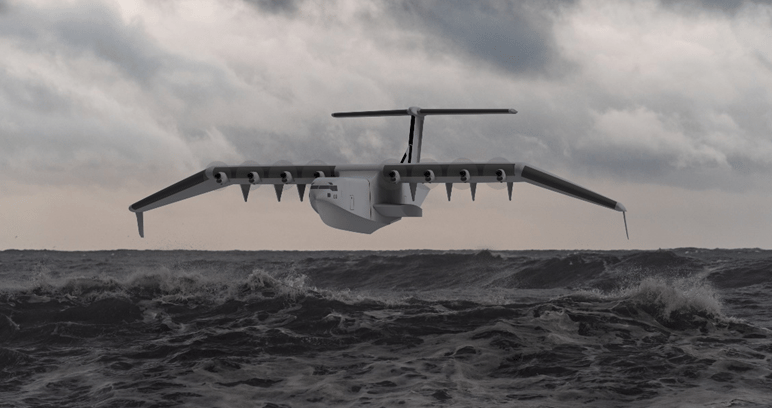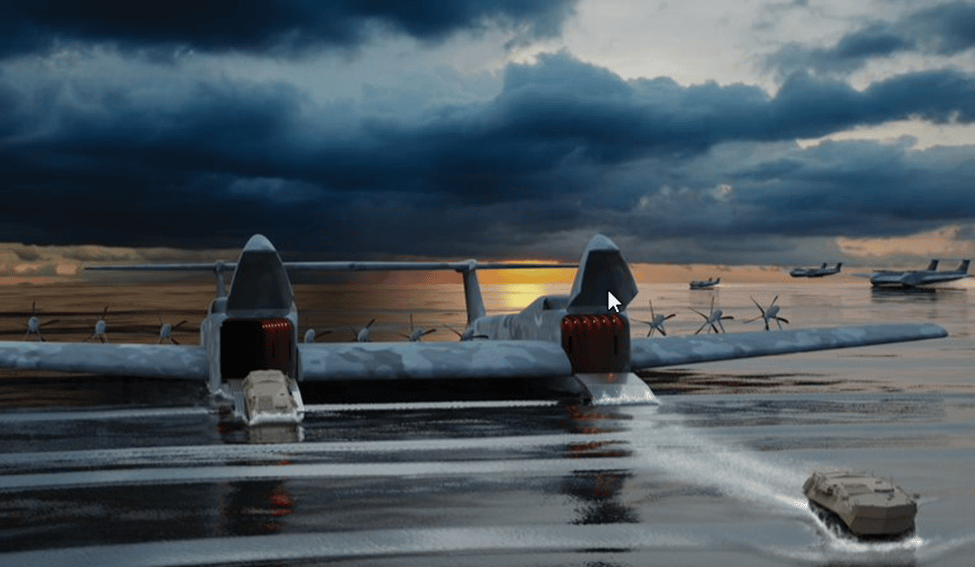DARPA has chosen two radically different designs from teams led by General Atomics and Aurora Flight Systems for development of the Liberty Lifter Seaplane Wing-in-Ground Effect full-scale seaborne strategic and tactical heavy lift demonstrator.
In 2022, DARPA announced its project to develop an aircraft, called the Liberty Lifter, with the size and capacity of a C-17 Globemaster III transport aircraft, yet could lift over 100 tonnes of payload. That’s pretty impressive, given that a C-17 can only manage about 77 tonnes on its best day, and that the Liberty Lifter is supposed to be a seaplane with a ferry range of 6,500 nm (7,500 miles, 12,000 km). That’s enough to fly from the North Pole to the Equator with a bit to spare.
The secret of this performance is what is called “ground effect” or “wing-in-ground effect,” which is an esoteric aerodynamic phenomenon that was at the center of one of the great mysteries of the Cold War.
In the late 1960s, American spy satellites watching the Soviet Union saw a strange, very large aircraft tearing about the Caspian Sea. Dubbed the Caspian Sea Monster by the intelligence community, it had analysts scratching their heads because this monster of an aircraft weighing over 500 tonnes had thick, stubby wings that couldn’t possibly support it in the air.

DARPA
It turned out that the mystery craft was an ekranoplan, which were a series of ground effect vehicles being developed by the Soviet military that could evade radar detection while carrying a heavy missile load by flying at very low altitude.
It was the very low altitude that was the key. Ground effect occurs when an aircraft is flying very close to the ground or, preferably, water. Without going into too much technical detail, when an airplane is moving forward at low altitude, it acts as if a cushion of air is trapped between it and the ground. As a result, drag is reduced and lift is increased, so the aircraft can either have smaller wings, carry a heavier load, or some combination of both.
This is why the Caspian Sea Monster could be so large and fly with such stubby wings. Unfortunately, such ground effects craft have severe limitations. One of the biggest of these is that they work best flying over a surface of flat calm water and they definitely don’t like rough seas.
DARPA’s Liberty Lifter project hopes to not only overcome some of these shortcomings, but to also take the technology a step further to create an aircraft that can ferry heavy loads over a great distance, can land and take off on water to eliminate the need for runways, can be put together using inexpensive boat-building techniques, and can operate for weeks without maintenance.

DARPA
In addition, it must be able to take off and land in Sea State 4, where the waves reach as high as 8.4 ft (2.5 m) and operate on water in Sea State 5 with waves up to 13.1 ft (4 m). It must also be able to function as a low-altitude aircraft that can fly out of ground effect to an altitude of 10,000 ft (3,000 m) above sea level.
For Phase 1 of the project, Aurora Flight Sciences, leading Gibbs & Cox and ReconCraft, is developing a craft that resembles a traditional flying boat, with a single hull, high wing, and eight turboprop engines. Meanwhile, General Atomics and Maritime Applied Physics Corporation are working on a more exotic twin-hull, mid-wing design for better water stability and seakeeping, while propulsion is provided by 12 turboshaft engines
Phase 1 is expected to last 18 months, with six months of conceptual design work and nine months of design maturation before the results are submitted for a preliminary design review and test/demonstration planning reviews three months later. This will be followed by Phase 2 in 2024 when the successful design will go forward to design, manufacture, and demonstrate a full-scale Liberty Lifter X-Plane.
“We are excited to kick off this program and looking forward to working closely with both performer teams as they mature their point-of-departure design concepts through Phase 1,” said DARPA Liberty Lifter Program Manager Christopher Kent. “The two teams have taken distinctly different design approaches that will enable us to explore a relatively large design space during Phase 1.”
Source: DARPA
Source of Article